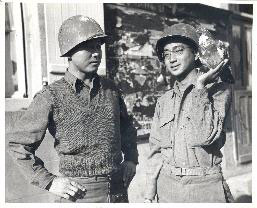
James N. Yamamoto (left) and Theodore T. Yamate (right), with the Headquarters' pet pigeon. France. October 12, 1944. Courtesy of the United States Army Signals Corps.
On average, the company consisted of about 115 men, including both officers and enlisted. The company was organized into ten different sections, including Company Headquarters, Regimental Headquarters, Regimental Supply, Ammunition, Motor Pool Maintenance, Transportation, Postal, Personnel, Special Services (which handled leisure activities and the distribution of PX rations) and Public Relations.1





